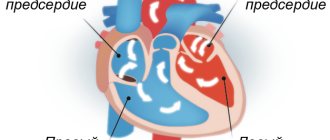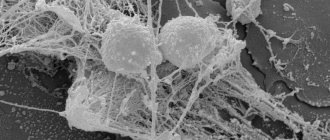Leukocytes are the main immune cells that protect the body from external and internal enemies. A condition in which there is an excess production of white blood cells is called leukocytosis in medicine. Their level may vary depending on various factors. They can increase during physical activity, in the evening, during stress, overwork, with pain of various origins, immediately after eating. To make the result as reliable as possible, blood is taken for analysis in the morning and always on an empty stomach. In addition, their levels are higher in pregnant women and children, and this is considered normal.
Why do expectant mothers have increased white blood cells?
During pregnancy, women systematically donate blood for analysis in order to identify pathologies and receive timely help. Doctors pay special attention to such an indicator as leukocytes. It is important that their level is not high or low.
Increases in white cell levels during pregnancy may be physiological or pathological. In the first case, this condition is due to the following reasons:
- eating;
- taking a hot or cold shower;
- emotional excitement;
- excessive physical activity;
- the pregnancy itself.
The increase in white blood cells during pregnancy is due to the fact that during this period white cells accumulate in the submucous uterine lining. This usually occurs in the second trimester and stimulates the contractile function of the reproductive organ and prevents infection from penetrating the fetus.
Thus, leukocytosis not caused by a disease does not require treatment. This is a typical increase in immune defense during pregnancy. The total white blood cell count increases by about 20 percent. At the same time, the level of different types of white cells changes differently. The leukocyte formula of a pregnant woman is as follows:
- band neutrophils are increased;
- segmented neutrophils are increased in absolute value;
- lymphocytes are moderately reduced both in number and percentage;
- eosinophils are reduced both in number and percentage.
Leukocytosis during pregnancy can be both physiological and pathological
If the level of white cells is above 10X10⁹/liter, then we are talking about leukocytosis, which is considered a pathological condition. The causes are various inflammatory diseases. These include:
- Respiratory tract infections such as pneumonia, bronchitis. The main symptoms of these diseases are cough and fever.
- Acute bacterial infections accompanied by high fever: cholecystitis, pyelonephritis, appendicitis.
- Purulent processes in which the level of white cells rises to 50X10⁹/liter. This is an abscess, blood poisoning, peritonitis.
- Meningitis is an inflammation of the meninges.
- Otitis media, characterized by fever, ear pain, ear discharge, and hearing loss.
- Significant blood loss.
- Anemia.
- Kidney failure.
- Hepatitis.
- Allergic reactions.
- Intestinal inflammation.
- Long-term use of medications.
- Rubella, measles, malaria, typhoid fever.
- Rheumatoid arthritis.
- Poisoning.
- Exacerbations of chronic diseases.
- Tissue damage due to injuries and surgical interventions.
- Severe burns.
- Oncological diseases.
- Lupus erythematosus.
When should you take a general urine test during pregnancy?
OAM should be taken on the recommendation of a gynecologist or other attending physician, regardless of the presence of complaints.
You can donate urine yourself before visiting a gynecologist for the following reasons:
- increase in body temperature
- chills
- malaise, weakness, headaches, depressed mood
- pain or discomfort in the lower back or abdomen
- cloudy urine with an unpleasant odor
- pain and difficulty while urinating
- feeling of incomplete emptying of the bladder and urinary retention
Leukocytosis in smear
When conducting blood tests in pregnant women, special importance is attached to the level of leukocytes. During this period, its increase is a physiological norm.
When registering, all pregnant women undergo examinations, during which leukocytes are detected in a vaginal smear. This is a characteristic phenomenon for all women expecting a child, and it is considered the norm. An elevated level (more than 20 units) indicates the presence of pathological processes. As a rule, these are inflammations of the urinary tract, including:
- candidiasis (thrush);
- vaginitis;
- cystitis;
- colpitis
The causes of these disorders may be associated with a weakening of the body's immune defense, hormonal imbalance characteristic of this period, and sexual transmission of infection.
Preparing for a general urine test during pregnancy
Preparation for OAM in pregnant women includes a number of hygienic procedures, as well as general restrictions.
- On the day before taking biomaterial, it is advisable to refrain from physical activity, drinking alcohol, and not eat vegetables and fruits (beets, carrots, citrus fruits, watermelons), red wine, and multivitamins, which can change the color of urine.
- Avoid taking diuretics for 48 hours before urine collection (in consultation with your doctor).
- You must abstain from sexual intercourse for 12 hours before the test.
- Before collecting urine, thoroughly clean the external genitalia. To prevent vaginal discharge from being included in the test, it is recommended to place a cotton swab in the vagina before taking the test.
- The average portion of urine is collected during the first morning urination (the first and last portions are flushed into the toilet). Urine can be collected at any time during the day.
- When collecting urine, it is advisable not to touch the container to your body.
- It is advisable to deliver the container with urine to the medical office within 2 hours after collecting the biomaterial.
Clinical manifestations
Leukocytes during pregnancy are determined in the laboratory and assessed over time.
In 75% of clinical cases, leukocytosis during pregnancy is asymptomatic and is detected only in the laboratory. Considering that leukocytes indicate an infectious process of varying severity, symptoms depend on the characteristics of the underlying disease:
- headaches, dizziness, fainting;
- increased temperature (from low-grade fever to severe hyperthermia, when the number of leukocytes is significant);
- apathy, malaise;
- signs of intoxication – nausea, vomiting;
- decreased vision;
- pain in the lower abdomen;
- shortness of breath, difficulty breathing;
- excessive sweating.
With nephrourological problems, dysuric disorders, increased leukocytes in the urine, and painful urination are observed. If typical symptoms of cystitis, urethritis, or vulvovaginitis appear, an extensive diagnosis should be carried out.
With physiological leukocytosis, there are no characteristic symptoms, but mild malaise, fatigue, and weakness are possible. The persistent appearance of disturbing symptoms requires mandatory monitoring by specialists.
Dangerous symptoms are severe abdominal pain, high fever for more than 2-3 days, fainting, profuse vomiting, acute lower back pain, blood or pus in the urine. In case of depression of consciousness, urgent hospitalization is necessary in the department of pathology of pregnant women or another appropriate profile.
Preventive actions
Increases in white blood cell counts in body fluid tests can be prevented by following simple clinical guidelines:
- sexual contact using a condom;
- frequent and adequate genital hygiene;
- eliminating bad habits;
- protective regime, prevention of hypothermia, colds;
- timely treatment of viral infections;
- adequate asepsis of pustular lesions on the skin and mucous membranes.
In the early stages of gestation, it is important to carry out sanitation of the oral cavity in order to exclude periodontal disease, periodontitis, deep caries, and stomatitis. Pregnancy reduces a woman’s immunity, so even minor inflammatory foci can lead to the spread of infection throughout the body.
Treatment tactics
Treatment of leukocytosis during pregnancy is prescribed carefully. It is important to take into account the level of high indicators, the degree of the inflammatory process, and the nature of pregnancy. If the indicators are elevated, according to studies of vaginal microflora, local therapy or observation is limited. Typically, after childbirth, the vaginal microflora returns to normal. In other cases, the following drugs are indicated:
- antibiotics;
- uroseptic drugs for inflammation of the kidneys and urinary system;
- immunomodulators to enhance local and systemic immunity.
In the treatment of this condition in women, preference is given to herbal-based drugs to minimize side effects and risks to the growing fetus. The total duration of treatment is 7–14 days, after which a control analysis of vaginal secretions and other biological fluids is indicated. In severe cases, therapy is carried out in a hospital setting.
Interpretation of urine analysis during pregnancy
Deviations from the norm of many indicators may be of physiological origin or indicate various pathological processes in the body. It must be remembered that interpretation of the results of a general urine test should be carried out only by the attending physician or gynecologist, since the results of laboratory tests are not the only criterion for making a diagnosis and prescribing appropriate treatment. They should be considered in conjunction with medical history and the results of other possible examinations, including instrumental diagnostic methods.
Color. The normal color is yellow of varying intensity. It may change when you eat certain foods and take certain medications. Whitish, dark brown or other uncharacteristic color indicates the presence of pathology. Urine should be clear.
Urine reaction . Normal pH is 5-7 (slightly acidic reaction). Increased acidity is characteristic of feverish conditions, renal failure, diabetes mellitus and other pathologies. An alkaline reaction is observed in chronic infectious diseases.
Density readings are used to assess kidney function. During the day, the specific gravity of urine fluctuates.
There is normally no protein in the urine Its appearance is a marker of the presence of various diseases (inflammatory infectious diseases of the urinary tract, kidney pathology and others). Protein is also detected in the urine after severe hypothermia, high physical activity, and a small amount may appear during pregnancy.
There should normally be no glucose Its detection in a biomaterial sample may indicate the presence of diseases (diabetes mellitus, pancreatic cancer, pancreatitis, etc.), as well as severe stress and consumption of large amounts of carbohydrates. But normally it can occur in small quantities in pregnant women. As a rule, abstaining from consuming simple carbohydrates leads to normalization of this indicator in the urine.
Bilirubin is detected in hepatitis, cirrhosis, obstructive jaundice and other pathological conditions associated with liver damage.
Urobilinogen in high concentrations indicates liver damage, hemolytic jaundice, and gastrointestinal diseases. An increased amount of ketone bodies indicates a disorder in protein, carbohydrate or lipid metabolism. Nitrites indicate a urinary tract infection.
Flat epithelium is the superficially located skin cells of the external genitalia. Detection of it in urine has no diagnostic value.
Transitional epithelium is found in the kidneys, ureters, bladder and upper urethra. Single cells can be found in urine sediment in healthy people. They are found in large quantities during intoxication, after instrumental interventions on the urinary tract, with jaundice, kidney stones and chronic cystitis.
The renal epithelium in healthy people is not found in sediment microscopy. Found in patients with nephrosis and nephritis.
Red blood cells are normally present in urine in small quantities. A small number of red blood cells can be observed after sports activities, lower back injuries, hypothermia and overheating. The appearance of a large number of red blood cells in the urine can occur in various pathologies (glomerulonephritis, nephrosis, collagenosis, heart disease, sepsis, influenza, infectious mononucleosis, rubella, tonsillitis, dysentery, etc.).
Leukocytes are present in the urine of healthy people. An increased number of leukocytes in the urine of women can occur when urine is contaminated with vaginal secretions. A high content of leukocytes in the urine occurs with pyelocystitis, pyelonephritis, fever of various origins, and genitourinary tract infections.
Cylinders are cylindrical structures that are primarily composed of protein and/or cells. They are usually found in pathologies of the urinary system (glomerulonephritis, pyelonephritis, renal tuberculosis, diabetic nephropathy, chronic kidney disease, renal amyloidosis, fever, scarlet fever, myeloma, osteomyelitis, systemic lupus erythematosus, etc.).
Mucus performs a protective function and is secreted by special cells of the genitourinary system. Normally, its content in urine is insignificant, but during inflammatory processes it can increase.
Salt crystals appear depending on the pH of urine and its other properties, and diet. May indicate mineral metabolism disorders, the presence of stones, or an increased risk of developing urolithiasis.
Bacteria indicate a bacterial urinary tract infection. But they can occur when urine is contaminated with bacteria from the skin and vaginal discharge.
At the medical office, you can get personal advice from a Doctor Q service doctor on deciphering the results of a urine test during your appointment or by phone.










